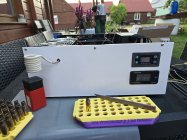The metallurgists on here could answer that better but from what I’ve read nothing happens to the grain structure at that low a temperature especially for the amount of time it is exposed.
Not exactly, but the part about trying to flash anneal the neck requiring higher than 750F is correct.
We investigate cartridge brass if exposed to higher than 400F. Not to belabor the point, but that is because in thin sections things happened differently that they do in thicker sections like the ones used in standardized metallurgical testing. Most times things were okay, but not always, which meant things do start happening below 750F but not the things we are discussing here.
Brass has some magical properties, and one of them is a gift to home reloaders when it comes to annealing necks. You would spend a lot of money trying to calibrate temperature sensors or hardness values if it were not for a little gift called The Draper point.
The Draper Point is a phenomenon for all metals and almost all solid materials. It is the temperature where the "glow" or spectrum of light emits a particular frequency that we find in almost all metals to be about 798K (977F or 525C) plus or minus just a little. It also just happens to be the temp range for flash annealing cartridge brass.
For a home reloader, in a darkened room when that first faint infrared glow starts, we can safely say we are at about 525C (977F). When the cartridge brass necks are bought to that temperature for just a heartbeat, the hardness value will usually be between 90 - 115 HV.
To keep things simple, if you bring the neck and start of the shoulder junction to a dull glow in a darkened room for a heartbeat and you followed up with hardness testing, you would pass the annealing tests. If you try to get more picky about wanting a tighter spec on hardness, you time that process up or down just a little and you can move the hardness numbers up or down several points.
The heat rate concept is also worth mentioning. We don't want to ramp up so fast that the process is very sensitive to timing or subject to overshooting. We also don't want it so slow that the body gets over 400F.
With gas, the single or double torch method means you can get that glow on something like a 223 case in about 6 or 7 seconds for just a beat and be fine. With too much RF power in an induction annealer, you have to be mindful of going too fast and making the timing very critical or overshooting. Keeping that heat rate at about 7 seconds for a 223 or say 9 seconds for a 30-06, would make it easy to keep the process under control with respect to enough heat for annealing the necks but also not so slow that you over heat the body.
Using 400F Tempilaq in a stripe down the length of the body is a good way to observe the heat rate issue. As long as the Tempilaq stripe isn't showing that temp very far below the body-shoulder junction, then you are doing fine with respect to process control. You don't want to see that Tempilaq turning half way down the body or you are letting the process take too long.
So, Draper point (dull glow in a dark room) for the whole neck into the shoulder junction for just a beat, then use 400F to protect the case body. Just keep it simple and don't try to go too fast or too slow. YMMV
















